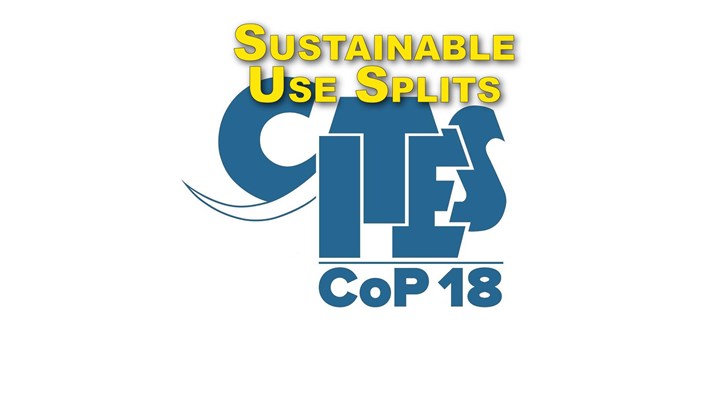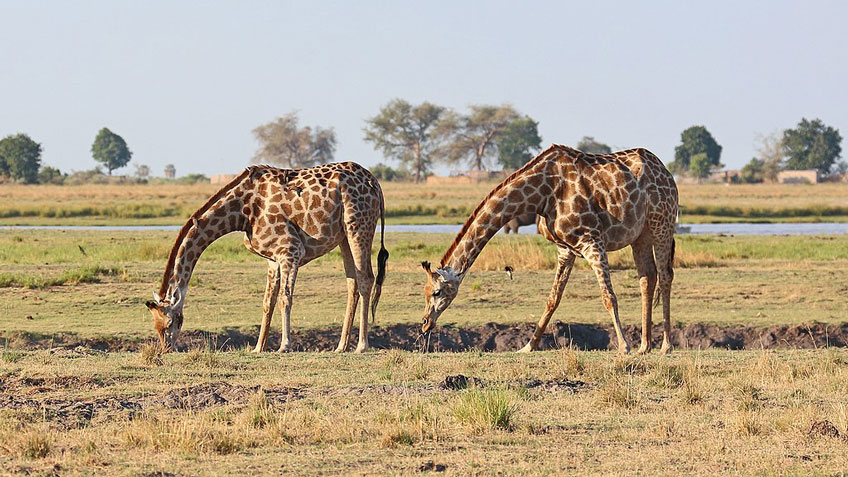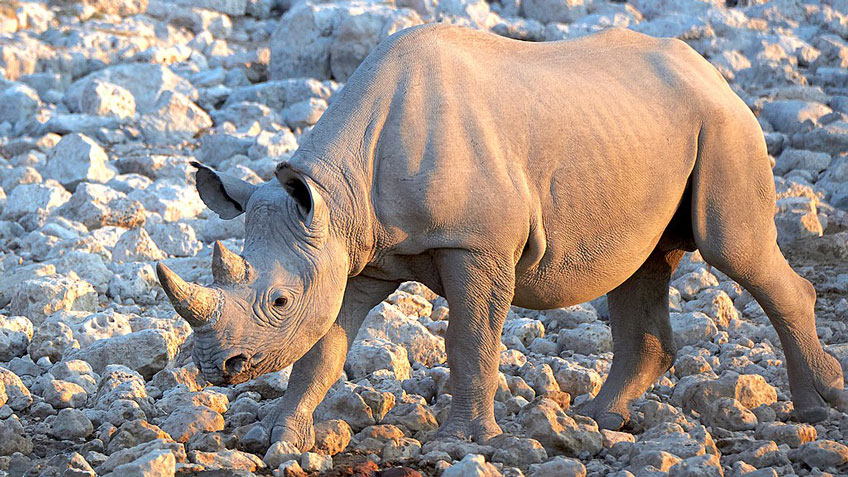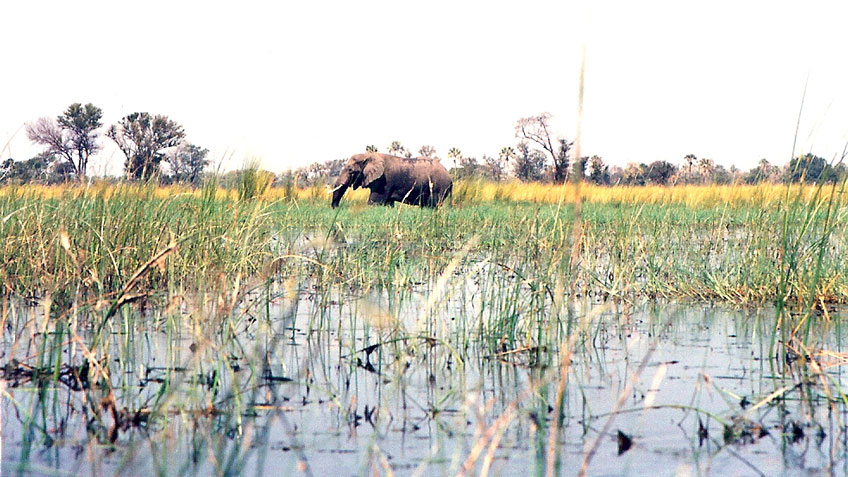
by Catherine E. Semcer - Thursday, September 12, 2019

During the last week of August, the 183 countries party to Convention on International Trade in Endangered Species (CITES) met in Geneva, Switzerland, to decide on a collection of proposals that from the outset were certain to have wide-ranging impacts on the conservation of African wildlife. The NRA Hunters' Leadership Forum website previewed the many issues on the table. The days of debate between delegates saw long-simmering tensions over trophy hunting and the sale of elephant ivory and rhino horn boil over to the point that some African nations are now openly questioning the treaty’s usefulness. The outcomes of the negotiations reveal a landscape of conservation diplomacy where historic norms are increasingly violated, science is ignored, deal-making is a lost art and attitudes are cooling toward employing sustainable use and trade to encourage conservation. Delegates to the Conference of Parties, or CoP, left Geneva shadowed by controversy and with the integrity of CITES in doubt. What will happen next is unclear, but what is certain is that the years leading up to the next CoP will be a critical time for the system of international trade that has helped trophy hunting enable African wildlife conservation.
The outcomes of the negotiations reveal a landscape of conservation diplomacy where historic norms are increasingly violated, science is ignored, deal-making is a lost art and attitudes are cooling toward employing sustainable use and trade to encourage conservation.Intended to address the risks to species conservation stemming from international trade, CITES sets export quotas and regulates the shipping of hunting trophies and other products of rare species across international boundaries. The ability of CITES to regulate where and to what extent hunting trophies can be exported gives the treaty the ability to make or break a country’s ability to integrate sustainable use into their conservation efforts.
The contentious debate at the recent CITES CoP resulted from ongoing disagreements among African nations and between members of the Southern African Development Community (SADAC) and influential countries and trade blocs like the United States, United Kingdom and European Union. Central to the dispute is whether countries that have been successful in conserving their wildlife should be punished with increased trade restrictions because of the failures of other nations. At issue is the export of hunting trophies of giraffe, rhino and elephant but also the ability of states to legally trade growing stockpiles of elephant ivory and rhino horn. On a deeper level, the dispute is over whether trade is recognized as a conservation tool or assumed to be a threat to species unless proven otherwise.
These issues were sharply illustrated in the decision to impose trade restrictions on giraffe for the first time in the treaty’s history. Led by Kenya, a coalition of East and Central African nations sought the restrictions in response to declines of giraffe that have reached as high as 97 percent in parts of the two regions. These declines have been driven by habitat loss, war and poaching of bushmeat for local consumption.

Giraffe
Contention over the proposal arose due to the fact that giraffe populations are abundant in SADAC nations, largely due to the economic incentives for conservation created by hunting and a trade in value-added products including hides, bones and meat. According to the 2016 giraffe status report from the International Union for Conservation of Nature (IUCN), the number of giraffe in South Africa has increased from 8,000 to 21,000 since the 1980s. In Angola the number of giraffe doubled from 15,000 to 30,000 in the same time frame.
The giraffe proposal presented the international community with an important question: Should nations that successfully employ sustainable use and trade to support species conservation be punished with trade restrictions to make up for the failures of countries that do not?
The question becomes keener when one considers that international trade, the raison d’etre of CITES, is not an accepted threat to Africa’s giraffes. This was pointed out by both the IUCN in its analysis of the proposal and the CITES Secretariat in recommendations to CoP participants. Both bodies also stated that the presence of large and well-distributed giraffe populations in the SADAC meant that the species failed to meet the treaty’s biological criteria for increased trade restrictions.
In what can only be characterized as a norm-busting vote, 83 percent of the nations present at the CoP, including the United States, ignored CITES’ core purpose, science and the recommendations of the Secretariat and answered the question with a “yes.” As Julian Fennessy, co-chair of the IUCN Giraffe and Okapi Specialist Group remarked, “Many people have talked about this being a nice political move with a lot of emotions behind it, but it doesn’t appear to be as scientifically robust as maybe it should be.”
The impact of the vote is likely to reach from southern Africa to the United States. Unlike the countries that sponsored the proposal, countries that allow giraffe hunting and trade in giraffe products will now need to invest scarce resources in setting export quotas that CITES will accept and expand permitting programs to ensure that all giraffe exports are CITES compliant. New export quotas are likely to impact national harvest quotas. How new quotas will economically affect the region’s hunting industry awaits to be seen.
The vote of the United States in support of the proposal may portend how the U.S. Fish and Wildlife Service (USFWS) plans to decide on a proposal to list giraffe under the U.S. Endangered Species Act. An ESA listing would create additional trophy import permitting requirements for U.S. hunters and could set the stage for the kinds of approval delays and outright import bans that have crippled segments of Africa’s hunting industry.

White Rhino
CITES’ turn away from sustainable use and trade continued in votes to reduce restrictions on the export of white rhino from Namibia and Eswatini (formerly Swaziland). Both countries sought to leverage sustainable use and trade to increase the amount of funding available for rhino conservation. In the case of Namibia, the country sought to expand trophy hunting and the sale of live animals while Eswatini sought to trade its growing stockpile of rhino horn.
As in the case of the giraffe, both the IUCN and the CITES Secretariat said that Namibia’s rhino population no longer met the biological criteria for the trade restrictions currently in place. The country is home to Africa’s second-largest population of the species, after South Africa, which enjoys the less restrictive trade barriers Namibia sought.
Eswatini’s rhinos are confined to two secure reserves. The cost of conserving these animals is rising due to the need for supplemental feeding to contend with ongoing drought and for increased anti-poaching resources. If allowed to sell the more than 700 pounds of rhino horn the country has accumulated in its stockpile, as well as the 44 pounds it expects to harvest each year going forward, the country could have the resources to invest more than $19 million in rhino conservation efforts.
In joining the majority of the CoP in rejecting both proposals, the United States relied on the kinds of hypothetical arguments that have been leading CITES down a path of viewing trade as a conservation threat instead of a conservation tool. In the case of Namibia, the United States stated a concern that the country might, at some point, sell live rhinos to Asian rhino farms where their horns would be harvested for commercial trade. With regard to Eswatini, the United States voiced concern that allowing trade in rhino horn might fuel rhino poaching.
Rejecting proposals like these on the basis that increased trade might, at some point, lead to undesirable outcomes turns CITES on its head. It moves the treaty away from its core purpose of regulating the international trade in wildlife and toward eliminating it via an overabundance of caution. Rather than making decisions based on the probable benefits to conservation that trade can produce, judgments are based on possibilities—whether or not they are likely based on the evidence. This saddles countries seeking to expand the use of trade as part of conservation programs with a burden of proof that is nearly impossible to meet. Such a burden risks discouraging investment in species conservation since expanded economic benefits are less likely to accompany expanded species populations while the financial costs of conservation to countries like Namibia and Eswatini will only grow.

Elephants
The costs of conservation and the deep divide between African nations were spotlighted in a series of proposals on African elephants. These included: an effort by Zambia to reduce existing trade restrictions to allow for increased trophy exports, the sale of raw ivory and trade in elephant leather; a proposal from a coalition of East and Central African nations to increase trade restrictions on elephants originating in the SADAC; and a proposal from SADAC nations to reduce restrictions so that they can sell their ivory stockpiles to raise funds for wildlife conservation and sustainable development. The collective outcomes of these proposals may have been the breaking point for a SADAC bloc that has grown increasingly weary of not being able to maximize the benefits of its conservation successes.
At its core, Zambia’s proposal to reduce existing trade restrictions on its elephant population would have recognized that the country’s elephants are no longer in danger of extinction. According to the IUCN Africa Elephant Specialist Group, Zambia’s elephant population is relatively large at 20,000 animals. In its guidance to CoP attendees, the IUCN noted that Zambia’s elephant population “is not small, nor does it have a restricted distribution. Although it underwent a marked decline since the 1970s, the population size appears to have been relatively stable in the last decade.” The CITES Secretariat echoed this conclusion in its recommendations to the parties.
Part of the rationale behind Zambia’s proposal is that threats to elephants are shifting away from commercial poaching and toward retaliatory killings stemming from human-elephant conflicts. Under Zambian law, the government is required to share the benefits of elephants with the rural people who live closest to the animals, but existing trade restrictions are making it harder to derive any substantial benefits at all. This has steadily transformed elephants from an asset into a liability and, in turn, increased risks to elephant conservation.
This rationale did not resonate with the majority of parties, including the United States. Like in the case of Namibia and Eswatini’s rhinos, the proposal was voted down due to an overabundance of caution. In this case the caution was grounded in the fact that some elephant poaching and illegal trade in ivory is still occurring in parts of Africa and that allowing limited, legal exports of raw ivory from Zambia might encourage criminal activity. Ignored were the probable conservation impacts that increased trade in elephant trophies and other products are likely to produce increased funding and increased social license for conservation while stemming the rise of retaliatory killings.
One rare bright spot for the SADAC at the CoP was the rejection of a proposal, led by Kenya, to increase trade restrictions on elephants originating from the SADAC. If the proposal had been adopted it would have imposed the same restrictions on elephant trophies originating from Zimbabwe, Namibia, South Africa and Botswana that the CoP put in place for giraffe.
As noted by this website in 2017, this proposal had been offered, debated and rejected at previous CoPs due to the targeted countries' exceptional success in elephant conservation, success that has been due in no small part to the economic incentives created by hunting. However, given the norm-breaking atmosphere in Geneva, it could not be taken for granted that parties would follow science and precedent and maintain the status quo.
Ivory
Finally, parties rejected a bid by Botswana, Zimbabwe, Namibia and South Africa to reduce trade restrictions to allow them to export raw ivory from their national stockpiles to raise funds for conservation and sustainable development. Maintaining stockpiles of ivory collected from naturally occurring deaths and criminal seizures can cost countries $100,000 a year, pulling limited funds away from conservation and increasing the financial costs of healthy elephant populations, especially if trade in hunters’ harvested animals, leather and other products are restricted.
The last sale of raw ivory from these countries allowed under CITES occurred in 2008. At the time, exporting countries agreed that no further proposals to trade in raw ivory would be made for a period of nine years, during which time CITES agreed it would develop a decision-making mechanism for allowing trade in raw ivory under the convention. Eleven years later, parties to CITES have yet to develop such a mechanism, suggesting that ensuring that trade in wildlife is sustainable and contributes to conservation has become less of a priority than limiting and preventing trade altogether.
For countries like those behind the proposal this atmosphere has become increasingly frustrating. There is a sentiment that they have gone above and beyond in using market-based mechanisms to conserve biodiversity while developing their economies and that they are now being punished by the international community with trade restrictions for doing so. Rather than being held up as the global standard for conservation, countries and non-governmental organizations (NGOs) are embracing the preservationist approach of countries like Kenya, where resistance to sustainable use and trade has inspired declines in generally common wildlife species by as much as 88 percent. If this atmosphere persists, it is likely to have negative consequences for wildlife conservation worldwide.
At the close of the CoP, Tanzania’s environment minister, George Simbachawene, took the floor to speak on behalf of the SADAC, making a declaration that was both bold and grave. Following is an excerpt:
“The way CITES is currently in operation is contrary to its founding principles. Today, CITES discards proven, working conservation models in favor of ideologically-driven anti-use and anti-trade models. Such models are dictated by largely western, non-State actors who have no experience with, responsibility for or ownership over wildlife resources. The result has been failure to adopt progressive, equitable, inclusive and science-based conservation strategies. We believe this failure has arisen from the domination of protectionist ideology over science in decision making within CITES.
"This anti-sustainable use and anti-trade ideology now dominates decisions made by many States who are party to CITES. States are increasingly influenced by the dominance both at meetings of the decision-making structures of CITES and, in their run up, by protectionist NGOs whose ideological position has no basis in science or experience and is not shared in any way by the Member States of SADAC and their people…
"The Southern African countries have observed, with great discomfort, the polarized discussions on African charismatic large mammals at this CoP. It is very disturbing to see the North-South divide across the African continent rearing its head again.
"We are further concerned that positions of some Parties appear to be based on national political considerations aimed at catering to the interests of national, intensively lobbied constituencies, as opposed to proven, science-based conservation strategies. This undermines the SADAC States, on whom the responsibility to manage species falls, and our ability to do so effectively. As it is currently implemented, CITES undermines the rights of people living in rural areas of SADAC States to have access to and use in a sustainable manner the natural resources present in their communities that are required to enjoy adequate living conditions and the right to participate in the management of these resources. The consensus expressed through CITES by the majority of States undermines our region in our efforts to secure social and environmental justice through the sustainable use of our natural resources. In doing so, it is compromising our ability to meet obligations and responsibilities to other multilateral agreements and to our peoples…
"We have been committed parties to CITES since its inception or our accession to it and would wish to remain so. But we can no longer ignore these glaring shortcomings and threats to our national interests and to our commitments to the broader multilateral context. Mr. Chairman, the time has come to seriously reconsider whether there are any meaningful benefits from our membership to CITES."
Mr. Chairman, the time has come to seriously reconsider whether there are any meaningful benefits from our membership to CITES.—George Simbachawene, Tanzania’s environment minister
In the days that have followed the close of the CoP, African ministers and heads of state have been actively discussing their future involvement in CITES. President Masisi of Botswana has called the treaty “senseless” and has pledged to lead the SADAC out of the pact. Namibia has stated it is actively considering withdrawal from the agreement.
Moses Chinhengo, Chair of the Zimbabwe Parks and Wildlife Management Authority, was quoted as saying, “Whether SADAC stays or pulls out of CITES is going to be a government decision… . Personally, there is nothing to persuade me that SADAC should remain in an organization that acts against our interests.” At the same time, Zimbabwe’s President Emmerson Mnangagwa has voiced a more measured approach, saying the country may use procedural tactics within CITES to sell its ivory stockpiles to Japan and China before considering a full pullout from the treaty. Japan is one of the few major markets to still allow a domestic trade in ivory. Ties between the two nations may be deepening following the recent Tokyo International Conference on African Development.
Which SADAC leader will ultimately set the agenda for the bloc’s relationship with CITES remains to be seen, as does what a nation’s withdrawal from the treaty would mean for hunters wishing to export their harvested animals from that country into the United States. What is abundantly clear at the moment though is that the convention’s drift from its focus on trade and its preservationist atmosphere is tearing the landmark conservation agreement apart.
Should the current rift become a chasm, it is likely to have grave consequences for efforts to conserve African wildlife. As the United States seeks to deepen its relationships with African partners it should seek to rise above some of its votes at the CoP and pivot to playing an active role in healing the divide that has emerged within CITES. It can send a strong signal to the rest of the international community by increasing technical and other support for the sustainable use programs of the SADAC nations while also providing similar support to the programs of countries like Kenya that help them reverse declines of wildlife that are fueling proposals like those adopted for giraffe. Doing so will ultimately make the United States and its African partners stronger, wildlife populations and rural communities healthier and set the right example for the rest of the world to follow.
About the Author:
Catherine E. Semcer is a research fellow with the Property and Environment Research Center (PERC) where her work focuses on free-market- and property-rights-based solutions to policy challenges in environmental security, conservation finance and sustainability. She is past chief operating officer of Humanitarian Operations Protecting Elephants (H.O.P.E.), a boutique non-government delivering training, advisory, assistance and procurement services to African counter-poaching programs. During her tenure with H.O.P.E. she was directly responsible for leading the opening of projects in Zimbabwe, Mozambique and Ethiopia.
Any opinions expressed here are her own and do not necessarily represent those of institutions with which she is affiliated.
Catherine’s research and commentary has appeared in NRA’s Hunter Leadership Forum, the International Journal of Environmental Studies, The Hill and other publications. She has also been a guest on programs including Intelligence Squared US and EconTalk, where she has debated and discussed the political economy of African wildlife conservation.
Catherine serves as a research fellow with the African Wildlife Economy Institute at Stellenbosch University in South Africa. She is a member of the Sustainable Use and Livelihoods Specialist Group of the International Union for Conservation of Nature (IUCN) and the Protected Areas Finance Working Group of the Conservation Finance Alliance. Catherine is a contributing editor to Conservation Frontlines and a past field editor of African Indaba, the official African publication of the International Council for Game and Wildlife Conservation (CIC.)
Catherine is a graduate of Muhlenberg College. In her spare time she enjoys upland bird and waterfowl hunting, trekking, fly fishing and sailing.
Follow NRA Hunters' Leadership Forum on Twitter @HuntersLead.
E-mail your comments/questions about this site to:
[email protected]
